Social media is too crowded and competitive. It’s hard to stand out organically. If your business is struggling on social media and it’s hard to generate engagement and leads, you should consider social media advertising. Running social ads significantly increases your chance of reaching the right eyeballs quickly.
If you are concerned about what makes social media ads powerful for your business and why you should spend money to reach your target audience on a social networking site when you can do it for free, this detailed guide is for you.
This article explores social media advertising, its benefits for businesses, and the top 5 best social platforms of ads that you should try.
What is Social Media Advertising?
Social media advertising (also known as paid social) refers to social ads that businesses run across social media networks to connect with their target audiences. Almost all social networking sites have dedicated ad networks where they let businesses run paid ad campaigns to reach their target audience. You can choose from a wide range of ad formats, placements, targeting options, and creatives to instantly reach your ideal customers on a social platform of your choice.
Meta, for example, has Ads Manager which is the integrated platform that’s specifically designed to manage advertising on Facebook and Instagram. You can manage ad campaigns, ad sets, ads, reporting, audiences, settings, billing, and more from your Ads Manager account.
The same goes for other social networking sites.
You don’t have to wait for months to reach your target audience organically on a social network of your choice. Social ads connect you instantly with any type of audience you like with tons of features and tools that aren’t usually available to non-business users.
Social Media Advertising Benefits for Businesses
The lucrative business benefits make social ads attractive and hard to decline. Here’s what makes paid social a powerful marketing approach:
1. Instant growth
Social ads provide instantaneous reach to your target audience that’s almost impossible organically. That’s similar to PPC campaigns where you get quick and targeted access to your ideal customers leading to heaps of traffic leading to growth.
Reaching your target audience organically on any social network is challenging and needs time. Data shows that only 1% of social content goes viral which is a reason the engagement on most of your social posts is always on the low side.
Statista reported that new Instagram accounts have a low growth rate which increases as the account gains more followers. New Instagram accounts grew by 9.4% in six months whereas accounts having 100K to 1 million followers grew by 16%:

For Instagram business accounts, it is even harder to grow them naturally. It is estimated that an Instagram business account organically increases its followers by 0.98% per month. This means it’ll take at least 5 years to reach 2K followers from 1K followers.
Social media advertising shortens this gap. You can get thousands of followers in a few days by running a page like ad campaign on Facebook. You can generate sales by sending traffic to your website from social media platforms.
Seltzer Goods created a well-thought social media ads strategy which increased monthly revenue by 25% with a 105% increase in total brand impressions:

Social media ads aren’t just limited to growing your social account, you can send traffic to a landing page, squeeze page, sales page, or any webpage to generate traffic, conversions, and sales. You can use social ads as a traffic generation source for your brand.
What makes social media advertising a powerhouse for your business is that it helps you achieve growth instantly that, otherwise, could take years to get.
2. Granular targeting
Paid social ads are extremely targeted because social networking sites have heaps of personal data about their users which advertisers can leverage. Selecting the right target audience with extreme accuracy increases the conversion rate of your campaigns.
Consider Facebook, for instance.
Users add a lot of personal details on their Facebook accounts that include interests, education, work history, life events, places they have visited, and much more. Facebook uses its data to show ads to the most relevant users while advertisers can improve targeting by pinpointing exactly what type of people they want to target.
Here is an example of Facebook’s detailed targeting feature:

If you want to target men between 30 and 40 who are married, live in Texas City, earn more than $100K from salary, are interested in gym and fitness, have at least one kid, and have a college degree, you can easily do so on Facebook.
This is what makes social media advertising a goldmine for businesses.
You don’t get access to such detailed targeting features organically. This is only limited to advertisers.
However, not all social networks provide similar targeting features. X, for example, doesn’t have such detailed targeting features as Meta as it doesn’t collect too much personal information about its users. LinkedIn has more work-related data and it’s suitable for B2B advertising. TikTok has limited targeting options due to a lack of personal data collection.
Social media sites also track data that’s used to improve ad personalization and targeting. It might not be available to advertisers as a targeting option, but social sites use it for UX. It includes contact info, search history, image recognition, and more:
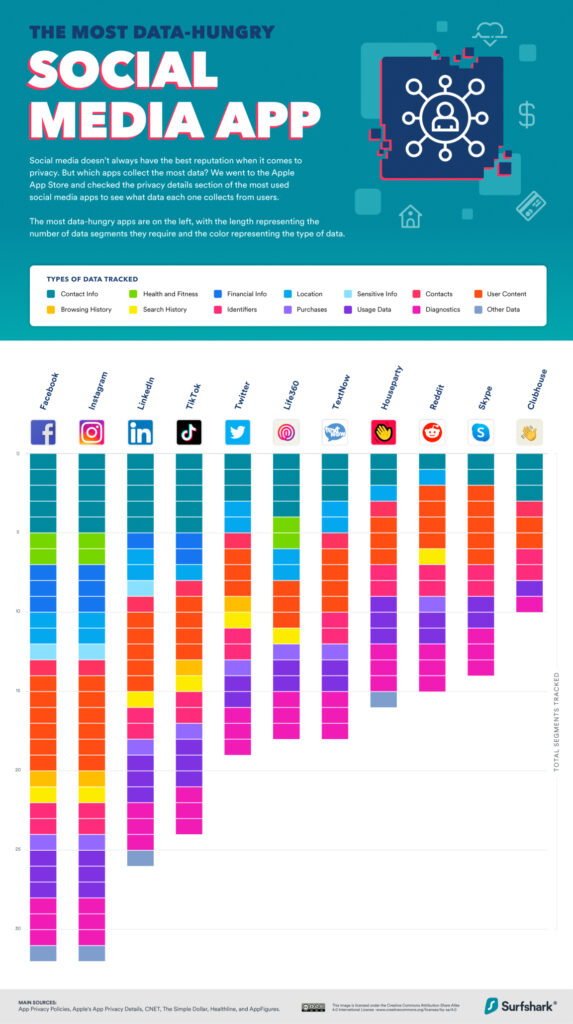
Facebook and Instagram are the only apps that track face, environment, and product recognition data:
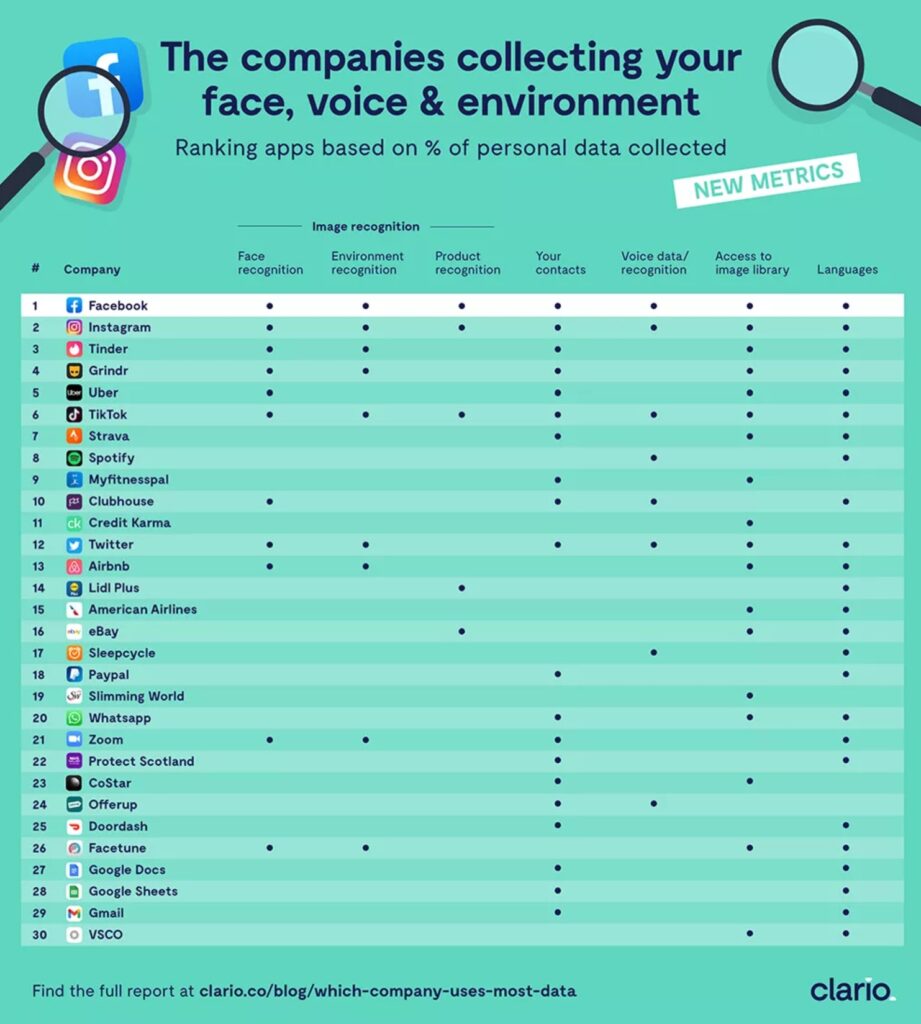
Meta is a beast when it comes to personal information and data tracking which makes these platforms among the top for social ads. You’ll get detailed targeting along with highly personalized ads that are more likely to have better ROAS.
Good or bad, data is the backbone of social media advertising as it significantly improves targeting, UX, and personalization.
3. Reach
Social ads have a massive reach. There are more than 4.95 billion social media users globally as of October 2023 with an average social media user spending 2 hours and 24 minutes per day on social media:

It is estimated that the total number of social media users worldwide will reach 5.85 billion by 2027:

You can best leverage social media’s massive reach through ad campaigns. It’s difficult to reach your ideal customers organically due to a lack of targeting options. Social ads give you full control over the reach. You can target people based on location and other demographics.
Interestingly, there is an upward trend in the number of social media users which means it is highly likely that most (if not all) of your target market can be using one or more social networks. You can reach them precisely with ads.
Here’s a list of the most used social platforms worldwide as of October 2023 with number of monthly active users in millions:
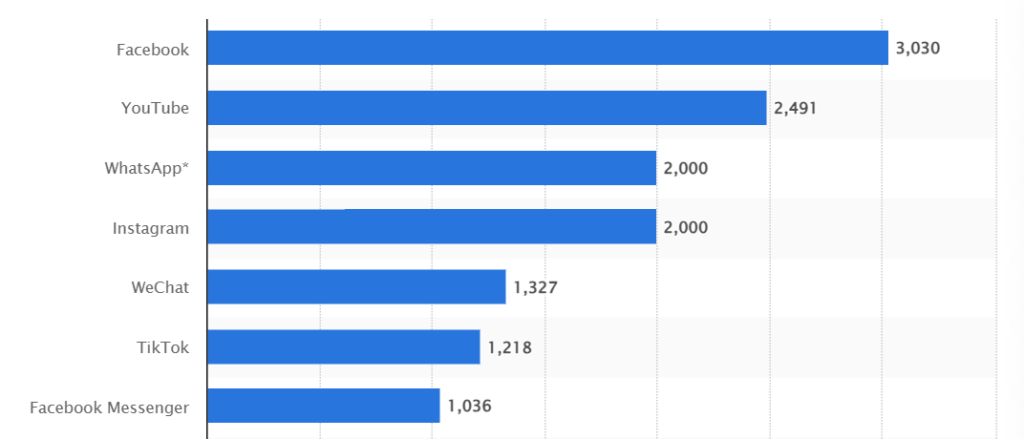
You can’t reach such a massive audience anywhere else except Google Ads which caters to a different audience type that might not be suitable for your brand.
4. Cost-effective
Social media advertising might not always be cheap but it is extremely cost-effective. When done right, you can achieve massive ROI and ROAS with social ad campaigns.
The cost per click (CPC) varies across social platforms, industries, ad formats, and other variables. The average CPC on social networks ranges between $0.40 and $3 except LinkedIn which has well over $5 average CPC:
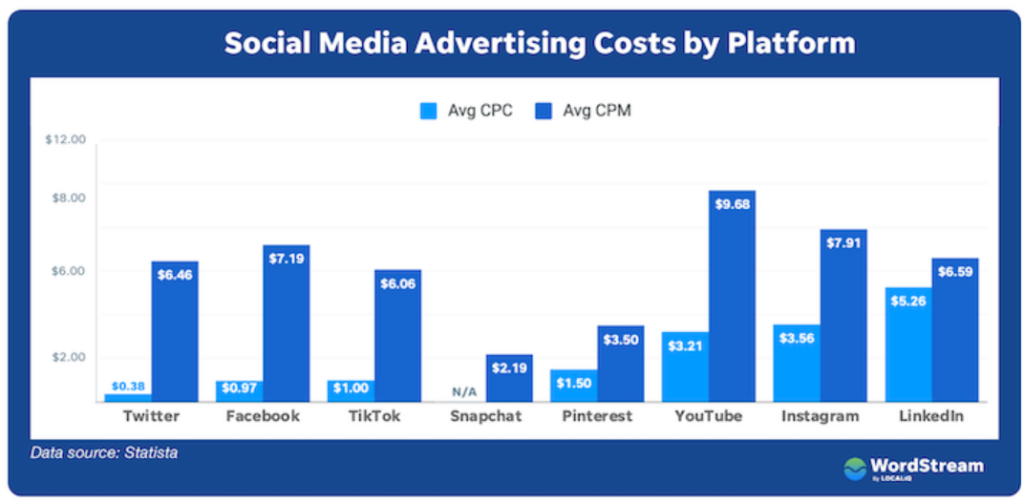
Here’s a breakdown of Facebook’s CPC by industry:
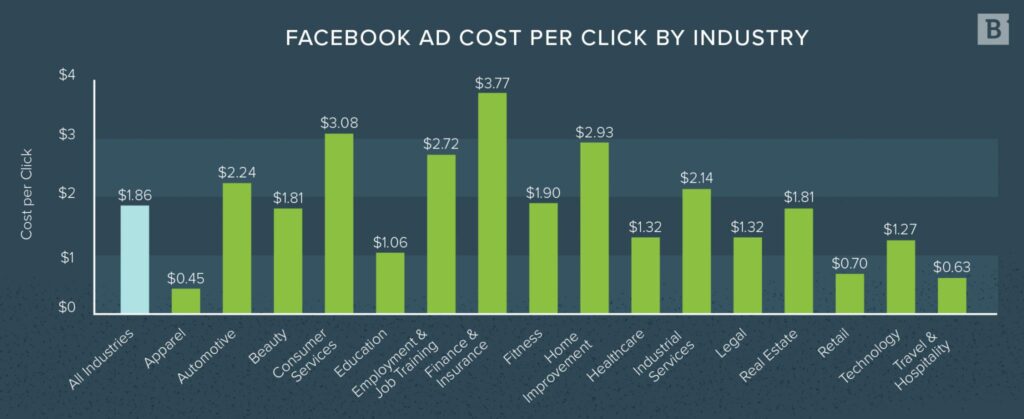
Apparel, travel and hospitality, and retail have the lowest average CPCs whereas finance and insurance has the highest. Similarly, if your target market is the US, you’ll end up paying a high CPC as opposed to targeting India where the average CPC is quite low.
Depending on what industry you are in, what social platform you are using, and what’s your target market, you can optimize and reduce social media advertising cost significantly.
It doesn’t just end here, the ROAS of social advertising is quite high because once you get paid engagement on a social ad, it starts driving organic engagement as well. People who like, comment, share, and tag their friends on an ad drive organic engagement.
It’s something you don’t get with Google Ads (such as search ads) where impressions are limited to a single person only.
This makes social media advertising cheaper and more effective than other forms of online advertisements.
5. Non-intrusive
Social ads are non-disruptive as they naturally appear in the user’s feed. This makes social ads user-friendly and thus, people don’t tend to dislike them.
Intrusive ads (also known as intrusive interstitials) ruin UX and they aren’t liked by users whether they are on or off social media. These ads cover the full screen of the user and block the actual content which leads to poor UX. Here are some examples of intrusive interstitials:
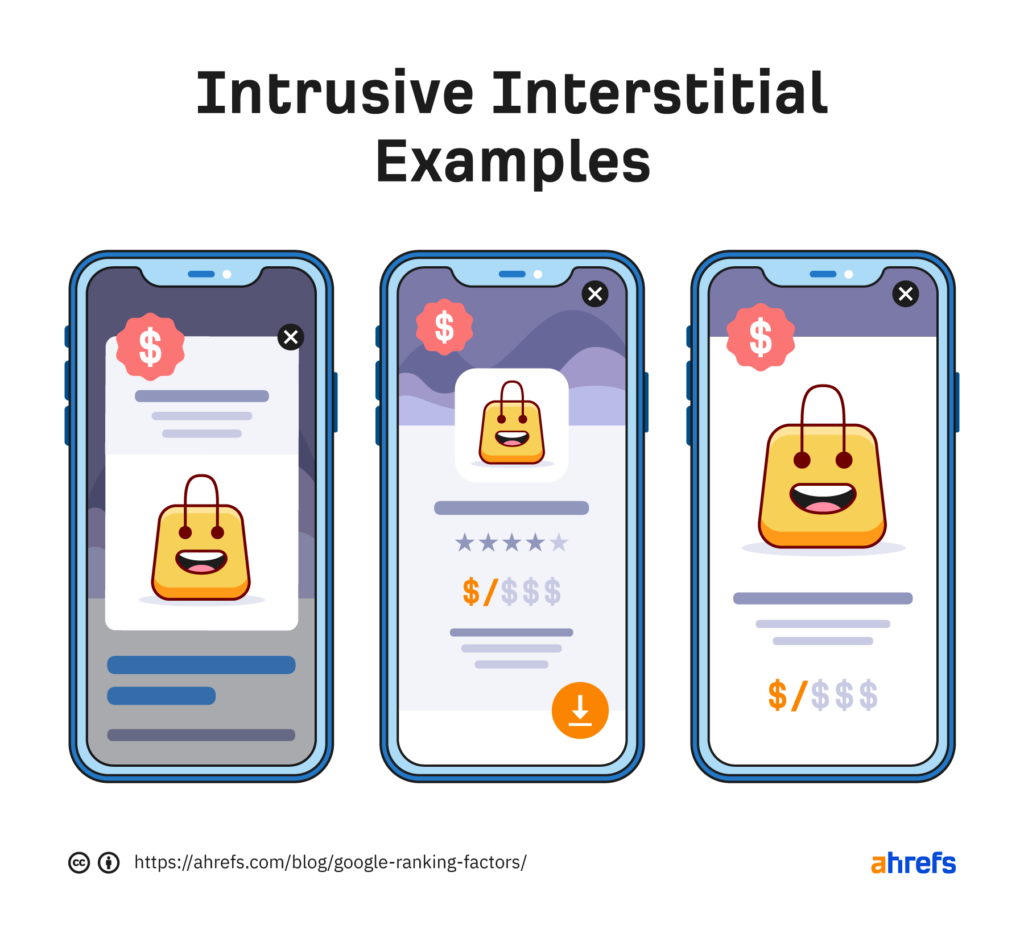
Social ads aren’t intrusive by nature and they don’t lead to negative UX. The ads appear naturally in the feed. The ads are also personalized and are relevant to the user’s interests. It’s something that people prefer. Research shows that 71% of people prefer personalized ads that are consistent with their interests while 81% of Gen Z and 57% of millennials in the US like personalized ads:

Social networking platforms do their best to keep ads non-intrusive and personalized to avoid negative UX. This works in the favor of social media advertisers. Here’s an example of a typical LinkedIn ad that appears normally in the feed with a ‘Promoted’ sign which indicates it’s a paid post:
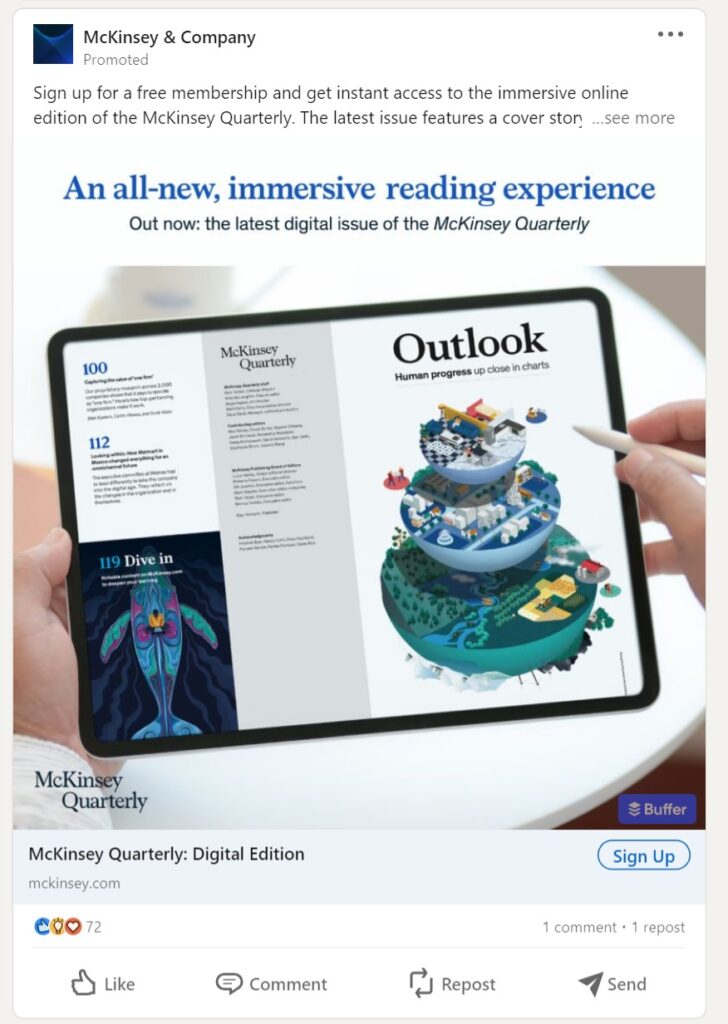
Your target audience is least likely to dislike such an ad. A potential user might scroll past such an ad or interact with it. The probability of getting annoyed with this type of ad is minimal (not zero though).
The top 3 reasons people dislike social media ads and might report them are:
- 74% of people dislike too many ads
- 63% of people don’t like seeing repeated ads of the same brand or product
- 44% of people are annoyed by irrelevant ads that don’t match their interests.
You can control ad frequency and improve targeting to address the second and third issues. The number of ads a person sees in the feed is out of the advertiser’s control.
Control what you can and your audience will love you for personalized, non-intrusive social ads.
6. Diversity
Social advertising offers you a lot of diversity in terms of the number of platforms and ad formats. There is something for everyone.
Depending on your industry and target audience, you have a lot of options to choose from. There are 35 social media platforms that have at least 100 million active users which gives you a lot of variety. You don’t get this with any ad network, not even Google ads (the biggest global ad network).
Social advertising networks offer you a wide range of diverse ad formats. X, for example, has 8 broad ad formats and each one of them offers sub-categories to choose from:
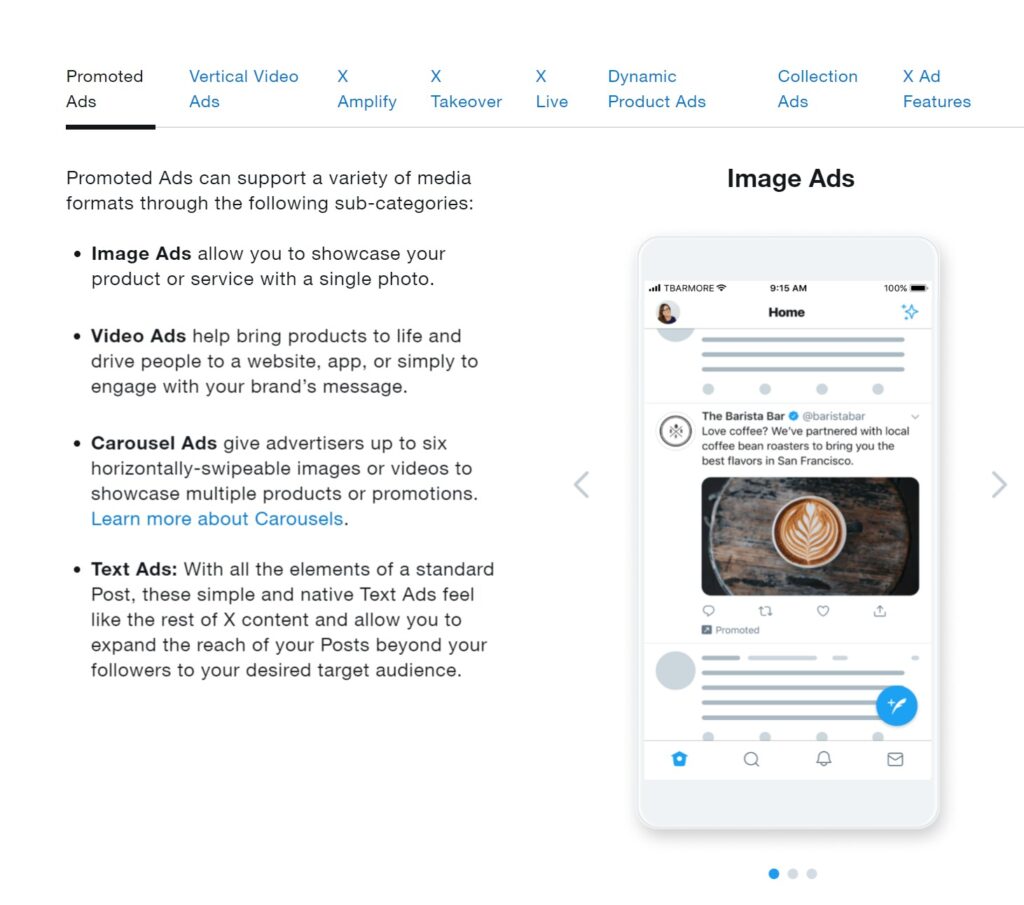
Instagram has 6 ad types with several formats across each type:
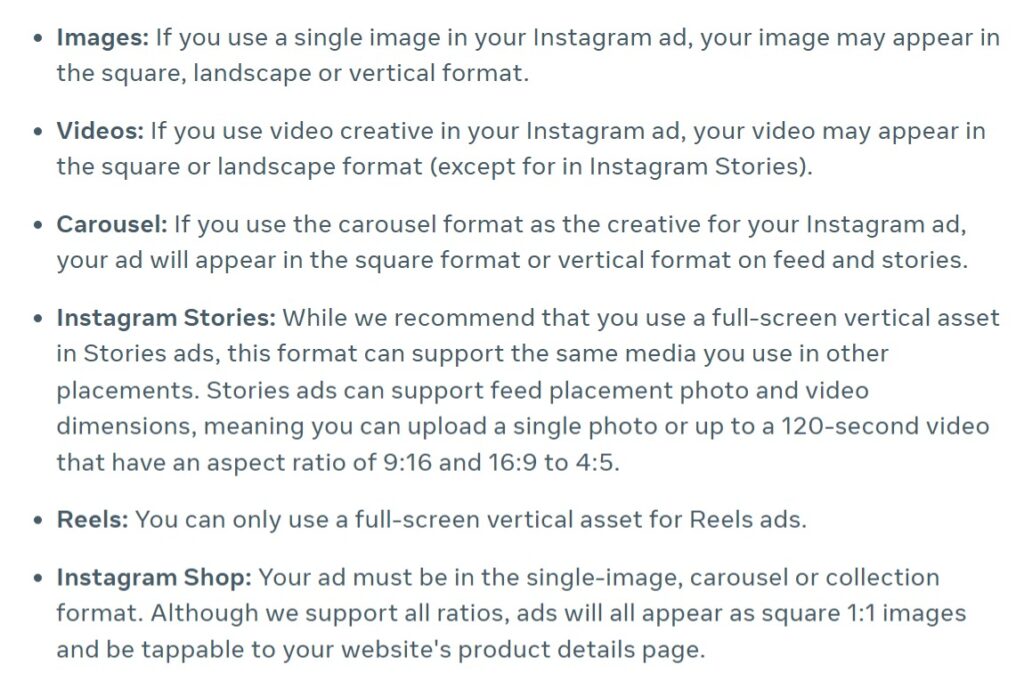
Having multiple ad types and formats give you more room for experimentation and you can reach different target markets with specific content needs easily. For example, you might have a buyer persona that only interacts with video content on X. You can target this buyer persona via a video ad campaign on X.
As a business, you never know how your audience responds to a specific ad format and type unless you give it a try and test it. This gets easier with social media advertising.
7. Detailed analytics
As a business user on a social media network of your choice, you have limited access to analytics. But when you run an ad campaign, you get detailed insights with a full-fledged reporting dashboard.
Real-time social ad analytics help you take preventive measures quickly and avoid wasting resources on underperforming ads and campaigns.
But the real fun begins when you get access to detailed analytics of your target audience. The data helps you understand your audience better. You can refine your buyer personas, tweak buyer journey, update sales funnel, and optimize marketing collateral based on advertising insights.
It helps you make data-driven decisions for future social media advertising campaigns. Data is known as the currency of the future, and you get it as a by-product of social ads. That’s a win-win.
Top Social Media Platforms for Advertising
Selecting the right social media network for advertising is crucial for success. You can’t randomly pick a social platform to run an advertising campaign. It has to align with your business and marketing strategies and your primary target audience must be on the social site.
The most popular social network isn’t always the right choice.
If your buyer persona doesn’t use one of the famous social sites but rather hangs out on a less popular networking site, you don’t have to waste your money on advertising campaigns on leading social apps. Be where your ideal customers are.
Top social media websites for social ads are relative. Don’t follow the crowd.
That said, here’s a list of the most popular social sites for paid ads:
1. Instagram
Instagram is the second most favorite social media platform in the world as of October 2023 according to GWI survey. WhatsApp is the most popular social app among both men and women but it doesn’t have advertising available as yet so we ranked Instagram as the top social advertising platform as it’s the most favorite globally:

Note: You can run WhatsApp message ads via the Meta Business Account since it is owned by Meta. Your ad doesn’t show in the user’s WhatsApp chat, but users are directed to WhatsApp chat after clicking a CTA in Facebook and Instagram ads.
Around 16% of people rated Instagram as their favorite social media platform which means it is one of the first networking sites you should check out for social ads.
As much as 62.4% of people use Instagram to research brands and products (which is the highest among other social media platforms. This makes Instagram the best social media advertising platform as users are actively searching for brands and products:

The average CPC and CPM on Instagram are a bit on the high side with an average CPC of $3.56 and an average CPM of $7.91. This is primarily because Instagram users are actively looking for products that significantly increase conversion rates and ROAS.
Instagram ads are best for:
- Brand awareness campaigns
- Businesses that target men and women between 16-34 as it is more popular among this age bracket
- High budget campaigns due to high CPC and CPM (due to high competition)
- Brands targeting India, the US, and Brazil as these are the top 3 countries with leading users.
2. Facebook
Facebook has more users than Instagram but it isn’t as popular as Instagram. It is rated by 13% of people as their favorite social networking app and 54.2% of people use Facebook for brand and product research purposes.
What makes Facebook advertising a must-have is its global reach. It has over 3 billion active monthly users and it is the most used social site in the world. No matter what industry you are in and what your target market is, you’ll always find some or most of your ideal customers on Facebook.
Meta has simplified managing and running ads on Facebook and Instagram. You can manage accounts from a single dashboard and cross-publish content conveniently, and run a single ad on both Facebook and Instagram without issues. This ease of use is quite persuasive for businesses. You can’t resist it.
The average CPC for Facebook ads is $0.97 which is quite low compared to Instagram and other social sites. The average CPM of $7.19 is also lower than Instagram and most of the other social platforms. Facebook ads are relatively cheap making it ideal for small businesses.
Facebook ads are best for:
- CPC campaigns
- Targeting a wide range of age groups anywhere between 16 to 64
- Small businesses and startups with low social advertising budgets
- Businesses targeting India, the US, and Indonesia as these are the top 3 countries with the highest number of Facebook users.
3. TikTok
TikTok is the favorite social media app of 7% of people which mostly includes females between 16-24 age group. More than 1.2 billion global TikTok users make it the 6th most used social media site.
You can choose from a wide range of ad types including feed ads, branded hashtags, spark ads, search ads, collection ads, and others. The average TikTok ads CPC is around $1 and the average CPM stands at $6.06. The CPM is lower than most of the other social networking platforms.
Around 43% of people use TikTok to find relevant products and companies which makes it an ideal place to reach your target audience. Research shows that millennials who use TikTok are 2.3x more likely to tag a brand in their posts and 92% of users take an action after watching a TikTok video.
What’s interesting is that 50% of TikTok users have purchased something after watching LIVE:

TikTok ads have high engagement when done right and this is a reason why you shouldn’t miss this growing social network for ads.
TikTok ads are best for:
- CPM campaigns mostly focusing on brand awareness
- Targeting females, especially between 16 and 24
- Businesses that can showcase their products via video content such as ecommerce stores
- Brands targeting the US, Indonesia, and Brazil.
4. X
X (formerly known as Twitter) is the favorite social platform of 3.2% of people. It stands out from the rest of the social networking sites as it focuses on text-based posts. The majority of people use X to keep updated about the latest local and international news and trends. Only 35% of people use it to find relevant products and businesses.
It has the lowest average CPC among all the social networking platforms which stands at $0.38. The average CPM is $6.46 which is comparatively cheaper. X is cost-effective but it lacks diversity as it’s more popular among men than women. An average X ad reaches 3x more men than women.
X is one of the best networks for advertisements as users are highly engaged. A whopping 93% of people plan to buy from companies they follow on X and 69% of them have already purchased from the brands they follow:

X users spend 26% more time viewing ads and this is a reason it drives 40% higher ROI than other social platforms. It is a must-try social networking platform for advertising.
X ads are best for:
- CPC campaigns
- Targeting men of all age groups
- Small businesses that can’t afford to run ad campaigns on expensive social platforms
- Businesses that target the US, Japan, and India as these are the leading countries based on the number of X users.
5. Pinterest
Pinterest is the favorite social platform of 1.5% of people which makes it a top social media site for advertising. Around 36% of people use Pinterest to follow brands and products followed by 20.8% who use it for entertaining content. It shows Pinterest is a goldmine for businesses as its user base is primarily interested in finding relevant products.
However, the majority of Pinterest users are females having an ad reach of 79.5% compared to 17.6% of ad reach for men:
Pinterest ads work exceptionally well as 75% of weekly users are actively shopping and Try-On enabled pins (that users can try via AR) are 5x more likely to lead to a sale. As much as 80% of pinners discovered a new brand or product on the platform.
But are ads affordable?
Well, the average CPC on Pinterest is $1.50 which is quite high as compared to other social ad networks like Facebook, TikTok, and X. The average CPM, on the contrary, is one of the lowest at $3.50.
Pinterest ads are best for:
- CPM campaigns
- Targeting females of all age groups
- B2C and DTC brands that have visually pleasing products
- Brands targeting the US, Brazil, and Mexico as these are the top countries with the greatest number of pinners.
Final Thoughts
Social media advertising is exceptionally powerful as it has the potential to generate unmatched engagement and conversions. When creating a social media ad campaign, you need to ensure that you choose the right platform based on your target market.
Running a social media advertisement campaign successfully with a high ROAS requires experimentation (A/B testing) and constant optimization. It needs time to see results so make sure you have enough advertising budget and resources to keep your campaigns running for weeks if not months.
Track ad performance and keep optimizing ads and campaigns to get more from your social ad budget.
Featured Image: Unsplash



